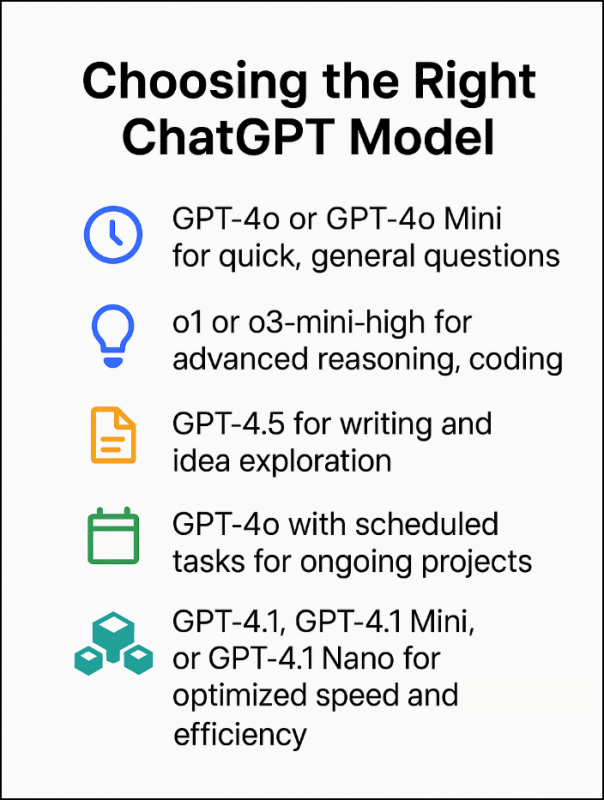In this post, we’ll take a close look at the various ChatGPT models available, their key features, and when you should consider using each one. This will help you understand how to choose the most appropriate model for your needs, whether you’re writing content, solving complex problems, or focusing on high-speed queries.

Understanding the Landscape: GPT Models vs. “o” Models vs. API-Only Releases
OpenAI’s model lineup has grown increasingly diverse, and understanding the key differences is crucial to selecting the right one for your task. While all of them are part of the GPT family, they fall into distinct categories based on their purpose, access method, and optimization priorities:
🔹 GPT Models (e.g., GPT‑4, GPT‑4o, GPT‑4.5)
These models are available through the ChatGPT interface and optimized for a wide range of general-purpose tasks such as writing, coding, reasoning, and tutoring. They offer strong overall performance and are ideal for users seeking versatility. GPT-4o, for instance, merges high-quality output with speed and multimodal input (text, vision, audio).
🔹 “o” Models (e.g., o1, o3-mini, o3-mini-high)
These are OpenAI’s lightweight reasoning-focused models, typically used for specialized cases like advanced logic, fast decision-making, or coding-heavy tasks. They are often deployed internally or via ChatGPT when response efficiency is needed, and they excel in logic, math, and structured reasoning.
🔹 API-Only Models (GPT‑4.1, Mini, Nano)
These are not available in ChatGPT directly, but instead exclusively via the OpenAI API for developers. GPT-4.1 and its variants (Mini and Nano) are tiered for different performance needs:
- GPT-4.1 balances depth and capability.
- GPT-4.1 Mini offers near real-time performance with solid quality.
- GPT-4.1 Nano emphasizes ultra-fast, low-cost inference for embedded or real-time applications.
These models are ideal for developers embedding intelligence into apps or services where latency, scale, or cost-efficiency are priorities.
1. GPT-4o: Great for Most Questions
What it is:
This is the default GPT model in the lineup, built to provide high-quality responses across a broad range of topics. Whether you’re seeking general advice, answers to specific questions, or need assistance in writing, GPT-4o excels at these tasks. It is a good all-around option when you’re unsure which model to choose.
When to use it:
- For typical, everyday queries where you need a reliable and articulate response.
- When you’re unsure which model is best suited for your question but still want solid quality.
- For general writing, brainstorming, or when seeking clarity on common topics.
2. GPT-4o with Scheduled Tasks (Beta): Ask ChatGPT to Follow Up Later
What it is:
This is an enhanced version of GPT-4o, offering the added feature of scheduling follow-up tasks. If you need help with projects that require multiple stages or continuous assistance over time, this model can be ideal. It allows you to set up follow-up reminders and tasks, which is useful for long-term or ongoing projects.
When to use it:
- When working on multi-stage projects that require checking in or follow-ups.
- If you’re managing tasks over a longer duration, like planning events or managing a series of deadlines.
- When you need more interaction over time, without manually prompting ChatGPT repeatedly.
3. GPT-4.5 (Research Preview): Good for Writing and Exploring Ideas
What it is:
GPT-4.5 is a special model focused on writing and idea exploration. It’s designed to help you create more structured content or dig deeper into topics that require extensive thought and creativity. This model can generate highly nuanced content, which makes it great for brainstorming, writing essays, articles, or coming up with detailed plans.
When to use it:
- When you need help with writing, whether it’s academic papers, blog posts, or creative pieces.
- For idea generation or brainstorming when you’re looking for in-depth exploration on a subject.
- When you’re working on a complex writing project that demands structure and critical thinking.
4. o1: Uses Advanced Reasoning
What it is:
The o1 model is optimized for complex reasoning tasks. It can analyze problems in a logical, structured way and is great at breaking down challenging questions or offering sophisticated insights. If you’re working on tasks that require high-level reasoning, decision-making, or analysis, o1 is the model for you.
When to use it:
- For complex problem-solving or in-depth analysis.
- When tackling tasks that involve logical reasoning, such as puzzles, mathematical questions, or strategic planning.
- For discussions or research that requires advanced synthesis of information and critical thinking.
5. o3-mini: Fast at Advanced Reasoning
What it is:
o3-mini is a lightweight, faster version of the o1 model. It provides advanced reasoning capabilities while being optimized for speed. This makes it a good choice when you need quick responses without compromising too much on complexity or depth.
When to use it:
- When you need a quick answer to a challenging question or when you’re working on something that needs faster turnaround times.
- If you’re on a time crunch but still require a high degree of reasoning.
- For analytical tasks that don’t require as much depth but still demand logical clarity.
6. o3-mini-high: Great at Coding and Logic
What it is:
This version of o3-mini is designed to excel specifically in areas of coding and logic. It is perfect for software development, debugging, algorithm design, or other tech-related tasks. If you’re looking for a model to help with coding or technical problem-solving, o3-mini-high is built to handle those efficiently.
When to use it:
- For coding-related tasks such as generating code, debugging, or understanding programming concepts.
- When you’re dealing with algorithm design or need assistance with technical aspects of your project.
- For rapid prototyping or when you need a quick review of your codebase.
7. GPT-4o Mini: Faster for Most Questions
What it is:
The GPT-4o Mini model is a lighter, faster version of GPT-4o. While it offers the same core capabilities, it prioritizes speed, making it ideal for when you need quick answers without the complexity that some of the other models offer.
When to use it:
- For fast, simple queries or when you need a rapid response to general questions.
- When time is of the essence, but you still require an accurate and reasonable answer.
- When you’re working on less complex tasks but want a quick solution.
8. GPT-4 (Legacy Model): Classic GPT-4
What it is:
The legacy GPT-4 model is the classic, full-version model known for its accuracy and ability to handle a wide range of tasks. While it’s still incredibly capable, it’s being phased out in favor of more optimized models like GPT-4o, but it remains a strong option for in-depth responses.
When to use it:
- For tasks that require a traditional approach with comprehensive and detailed responses.
- If you need GPT-4’s legacy capabilities and don’t mind using the older version.
- When working on projects where the highest level of output consistency is important.
Certainly! Here’s how you can seamlessly add a section for the new API-only models, following the existing format of your blog post:
9. GPT‑4.1, GPT‑4.1 Mini, and GPT‑4.1 Nano: Optimized for Speed and Efficiency
What they are:
GPT‑4.1, GPT‑4.1 Mini, and GPT‑4.1 Nano are the latest API-only models designed for optimized performance and resource efficiency. These models are built to handle both speed and accuracy, offering a streamlined experience for developers and users needing fast, responsive outputs.
- GPT‑4.1: The standard model in this family, providing a balance of depth, reasoning, and speed. It’s designed for general-purpose tasks that require higher performance and nuanced answers.
- GPT‑4.1 Mini: A faster, lighter version of GPT‑4.1, designed to prioritize speed while still maintaining a high level of accuracy. It’s great when you need quick answers but still require a thoughtful response.
- GPT‑4.1 Nano: The smallest and fastest model in the family, offering ultra-low latency and minimal computational load. It’s ideal for applications that need rapid results with minimal resource use, such as real-time systems or interactive tools.
When to use them:
- GPT‑4.1: Ideal for tasks that need a high level of depth but still demand efficient processing. Use this when working on general projects that require both complexity and accuracy.
- GPT‑4.1 Mini: Use this model when speed is the priority, and you want a quick yet reliable response. It’s perfect for applications where you need both performance and responsiveness without compromising too much on quality.
- GPT‑4.1 Nano: This is your go-to model when ultra-fast response times are critical, and you are working with limited resources. It’s best suited for interactive systems, low-latency applications, or when you need to minimize computational overhead.
Conclusion
Choosing the right ChatGPT model depends on the type of task at hand. Here’s a quick summary:
- General Questions: Use GPT-4o or GPT-4o Mini for quick answers.
- Writing & Idea Exploration: Go with GPT-4.5.
- Advanced Reasoning & Analysis: Choose o1 or o3-mini for faster, reasoning-heavy tasks.
- Coding & Logic: Opt for o3-mini-high.
- Scheduled Tasks: Use GPT-4o with scheduled tasks for longer-term engagements.
- Optimized Speed & Efficiency: For high-speed tasks and resource efficiency, consider GPT‑4.1, GPT‑4.1 Mini, or GPT‑4.1 Nano, depending on your need for speed, depth, or minimal resource usage.
By understanding the strengths of each model, you can tailor your approach for maximum efficiency and accuracy in your work. With the introduction of the API-only models like GPT‑4.1 and its variations, you now have even more options to optimize both performance and computational resources based on your specific needs.
This post was created with ChatGPT
